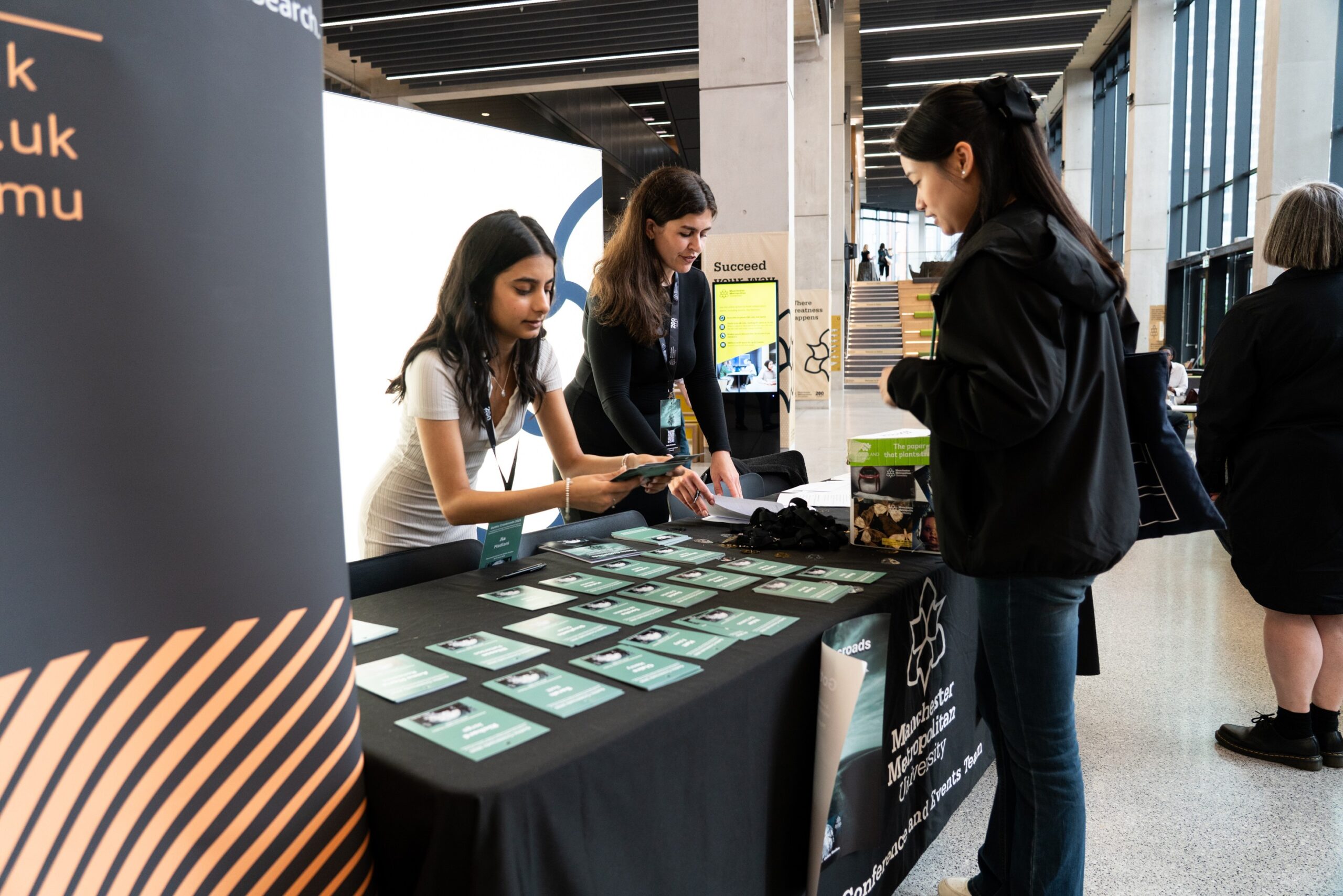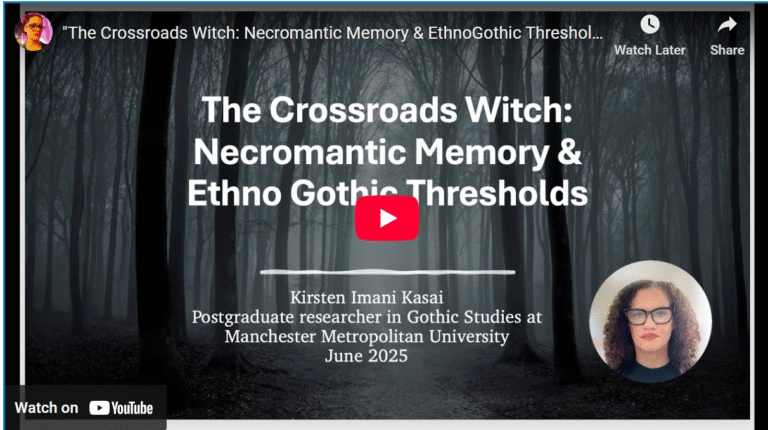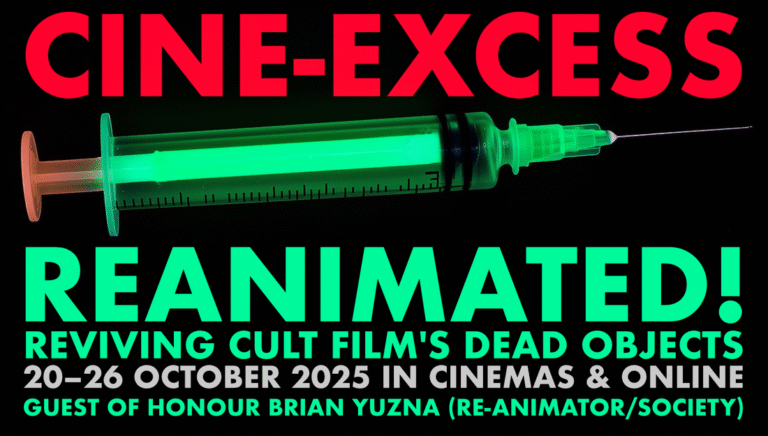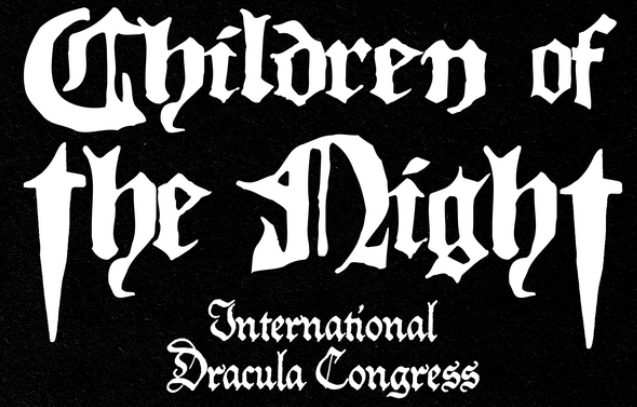The Gothic Crossroads Conference at Manchester Metropolitan University ran from the 25th- 27th of June and was organised by Dr Emma Liggins and Dr Eleanor Beal. I was hired as the Event and Communications intern alongside fellow student, Jia Madlani.

Our work commenced the week prior to the conference, where Jia formulated a Mentimeter to gather event feedback and designed a Gothic picture quiz for the social event on Thursday at Revolution. I curated a playlist for this event, aiming for an atmospheric blend of the eerie and the nostalgic, and also created the slideshow which played on the main screen in the Dalton building where the conference was held.

The following week, Jia and I put together around 150 conference packs on Tuesday. It took us just over an hour and left us both feeling like factory workers, but it was surprisingly therapeutic and a nice way to ease into what would become a very full and exciting week!


On Wednesday, we arrived bright and early to register attendees. This involved welcoming them, handing over their conference pack (which included a notebook, pen, programme and name badge), registering their attendance, and answering any queries. It was a little daunting for us both at first, but thankfully everyone was so warm and enthusiastic that the morning flew by. The Dalton building also hosted a Gothic Heritage Fair, which featured displays and artefacts from the Portico Library and Elizabeth Gaskell’s House, setting the perfect tone for the start of the conference.

In the afternoon, I attended a panel on American Gothic, Psychoanalysis and Paranoia, which was chaired by Professor Dale Townshend. The speakers explored the Gothic through psychoanalytic theory, the American landscape, and altered mental states. Meghan Kelley, a licensed psychoanalyst and incoming PhD student at MMU, gave a fascinating paper titled “The Skull of Freud,” in which she used Pet Sematary to explore transgenerational trauma and boundary violations in psychoanalysis, framing them through Gothic tropes such as the cursed burial ground. Sophie Bellenberg, a postgraduate researcher at UEA, presented a fresh reading of Georgia O’Keeffe’s desert paintings, arguing for their inclusion in the ‘Frontier Gothic’ tradition through their use of skull imagery and evocations of landscape trauma. Simon Schothans, a Dutch gothicist and researcher at Radboud University, delivered a highly philosophical and thought-provoking paper on “bad trips,” psychedelia, and ego-dissolution. Drawing on Lacan, Lefèbvre, and Lovecraft, he unpacked the spatial and psychic conditions that turn psychedelic experiences into horror, what he called LSD Gothic. His emphasis on structural paranoia as both a psychological and narrative mechanism was particularly compelling and I was particularly interested in his links to Slavoj Zizek’s work.
This was followed by Dr Maisha Wester’s plenary, “Coded Black: Gaming the Gothic for Social Justice,” which was one of the most powerful talks of the week. She explored how her game intentionally resists narrative closure, refusing a clear plot or ending to mirror the ongoing and unresolved nature of systemic racism. The game uses Gothic tropes to confront histories of Black trauma and oppression while pushing players to engage actively and ethically with these legacies. A lecturer even said they wanted to use the game on one of their modules, and a teacher mentioned adding it to their school curriculum, so I wouldn’t be surprised if it ends up being taught soon. After the plenary, guests enjoyed a wine reception, before Jia and I joined some of the attendees and staff for a lovely meal at Home, which was a great way to reflect on the day.

Thursday began much the same way, with morning registration. I attended a panel on the EcoGothic, chaired by Dr Francesca Brooks, which I found really interesting. The first paper was by Dr Joan Passey, Senior Lecturer at the University of Bristol and a BBC/AHRC New Generation Thinker. She discussed the coastal vampire as an Eco colonial metaphor, offering a beautifully theorised reading of queer ecologies and the Gothic shoreline through texts such as Dracula and The Blood of the Vampire. Her idea of the coastline as a ‘threshold space’ was particularly evocative.
Next, Jemma Stewart, a PhD student at Birkbeck, presented on the use of floriography in the Female Gothic. She showed how the sentimental ‘language of flowers’, originally intended to reinforce idealised femininity, was reappropriated by female Gothic writers as a tool of subversion and rebellion. Her idea of floriography being “remixed and reflowered” by the Gothic was striking, and she made a strong case for the radical potential in what might initially seem like an overly genteel tradition.
The final paper in the panel was from Jenny Wan Ying Chak, an MPhil student from the University of Hong Kong. She brought a transcultural Eco Gothic framework to premodern Chinese gardens, interrogating how literary spaces once thought to reflect harmony and balance also conceal deeper tensions around class, power, and control. Her comparison of literati gardens to Gothic landscapes in Western literature added a richly comparative dimension to the panel.


Later in the day, I attended Professor Rosario Arias’s paper, “Assembling and Crossing the Human and the Non-Human: The EcoGothic in Neo-Victorian Fiction.” A Professor of English Literature at the University of Málaga, Rosario explored posthuman entanglements and plant sentience in Neo-Victorian texts, foregrounding the often-overlooked environmental dimension of the genre. Building on the premise that Neo-Victorianism is “a quintessentially gothic movement”, she highlighted the surprising lack of critical attention given to environmental concerns within this area. Her paper sought to redress this by examining contemporary texts that reimagine motifs traceable to the nineteenth century, such as the mad scientist, the monstrous vegetal (including fungi), and the gothic gardener, through the lens of posthumanism and assemblage theory.
Her reading of embodied ecology, drawing on Paco Calvo’s Planta Sapiens, was particularly engaging, and I have since picked up the book to learn more about plant cognition and perception. Rosario’s discussion was theoretically rich, drawing on figures such as Deleuze and Guattari, Stacey Alaimo, Jane Bennett, Timothy Morton, and Michael Marder to illuminate the entanglements between the human and non-human vegetal. She also examined Donna A. Leahey’s “The Wisteria” and Noah Medlock’s A Botanical Daughter, which exemplify what she terms the EcoGothic’s capacity to challenge anthropocentric assumptions. “The Wisteria” has since made its way onto my reading list, promising further insight into the haunting interplay between environment, identity, and the spectral legacies of the Victorian past.

Later in the day, Jia and I attended Quen Took’s Contemporary Gothic Reading Group, where we discussed Andrew Joseph White’s trans horror novel Hell Followed with Us. It was a fantastic discussion that ranged from queer identity and trans embodiment to the novel’s intersection with environmental collapse and Native American trauma. The group created a really thoughtful space for critical reflection and personal connection.
The day ended with the Gothic social at Revolution, which Jia and I helped to set up with gothic-themed decorations and quiz materials. My playlist, which I had spent the previous week fine-tuning, filled the space with suitably moody vibes. The evening had a relaxed, celebratory atmosphere, and it was lovely to see attendees unwind and connect outside of the more formal panels.

On Friday, we registered the final group of attendees and joined the creative plenary session, which featured readings by Susan Barker and Michael Stewart. Susan read from her new novel Old Soul, while Michael shared an excerpt from Black Wood Women. I particularly enjoyed Michael’s piece and had the chance to catch up with him afterwards, we had previously met when I was a student at the University of Huddersfield. I asked him about the role of the wolf in his book and how he approaches ecocritical theory within his storytelling, and he had some fascinating thoughts on how Gothic tropes engage with land, ancestry and ecological memory.


The conference wrapped up with the announcement of the Manchester University Press Gothic Prize winners, a lovely celebration of emerging scholarship in the field.

Overall, it was a brilliant experience and I thoroughly enjoyed working alongside Jia, Emma and Ellie throughout the week. The conference offered so many fascinating insights and creative approaches to the Gothic, from games and fiction to heritage and plants, and it was exciting to witness how researchers and creators are expanding what Gothic studies can be.

About Ellie Croot
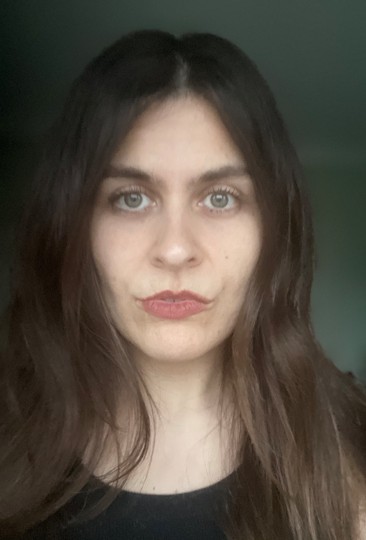
Ellie Croot is a final year English and American Literature student at Manchester Metropolitan University. Her primary interest is in 20th Century American literature with a particular focus on Beat and transgressive writing, notably the works of Charles Bukowski and William Burroughs. She is about to undertake an MA in International Relations at the University of Sheffield. She has interned for many events at Man Met, including English Employability Intern, Humanities Degree Show Intern and Communications and Event Intern, Gothic Crossroads Conference

